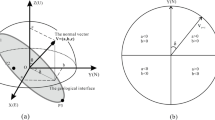Abstract
Point cloud contains a large collection of point data as surface returns to describe the multidimensional aspect of the topographic features. Data points within these point clouds at the atomic level convey little or no information about the structural, physical, and spatial information about objects of interest within the scene in its raw form. Analyzing the surface described as a set of the point is complex and challenging. This paper describes the framework and methods for analyzing topographical reliefs and terrain regions to extract surface features using spatial clustering and aggregation of point cloud data. The method also describes the effectiveness of Kd- tree and nearest neighbor estimates in segmenting and visualizing the surface topographical terrain and relief region. The morphological correspondence between the points within clusters and the corresponding surface is demonstrated. It is also defined as clusters and spatially varying aspects of the object structures for further studies. The result obtained with the experiments shows significant improvement in classifying and clustering small and large surface structures of topographic reliefs over other known methods. It establishes the relevance of using spatial clustering and the use of surface normals for clustering object structures of varying sizes on the earth's surface.








Similar content being viewed by others
References
Grekousis G (2020) Spatial analysis methods and practice: describe, explore, explain through GIS. Cambridge University Press, Cambridge
Liu X, Meng W, Guo J, Zhang X (2016) A survey on processing of large-scale 3D point cloud. Lect Notes Comput Sci (including subseries Lecture Notes in Artificial Intelligence and Lecture Notes in Bioinformatics) 9654:267–279. https://doi.org/10.1007/978-3-319-40259-8_24
Sharma M, Garg RD, Badenko V, Fedotov A, Min L, Yao A (2020) Potential of airborne LiDAR data for terrain parameters extraction. Quat Int. https://doi.org/10.1016/j.quaint.2020.07.039
Luo W, Zhang H (2015) Visual analysis of large-scale LiDAR point clouds. In: Proceedings of the 2015 IEEE international conference on Big Data, IEEE Big Data, pp 2487–2492. https://doi.org/10.1109/BigData.2015.7364044.
Horváth G, Erdős G (2020) Object localization utilizing 3D point cloud clustering approach. Procedia CIRP 93:508–513. https://doi.org/10.1016/j.procir.2020.04.132
Ramiya AM, Nidamanuri RR, Krishnan R (2016) Segmentation based building detection approach from LiDAR point cloud. Egypt J Remote Sens Sp Sci. https://doi.org/10.1016/j.actamat.2015.02.029
Jin X, Han J (2017) Partitional clustering. Springer, Cham
Mallet C, David N (2016) Digital terrain models derived from airborne LiDAR data. In: Optical remote sensing of land surface: techniques and methods. Elsevier Inc., pp 301–319
Schillaci C, Braun A, Kropáček J (2015) Terrain analysis and landform recognition. In: Terrain analysis and landform recognition and geography. British Society for Geomorphology, pp 1–18. Accessed 13 Dec 2017. [Online]. Available: http://geomorphology.org.uk/sites/default/files/geom_tech_chapters/2.4.2_TerrainAnalysis.pdf
Varghese BM, Unnikrishnan A, P. J. K, (2013) Spatial Clustering Algorithms - an Overview. Asian J Comput Sci Inf Technol 1:1–8
Mendes F, Santos MY, Moura-Pires J (2013) Dynamic analytics for spatial data with an incremental clustering approach. In: Proceedings of IEEE 13th international conference on Data Mining Work. ICDMW,pp 552–559. https://doi.org/10.1109/ICDMW.2013.169.
Otair M (2013) Approximate K-nearest neighbour based spatial clustering using K-D tree. Int J Database Manag Syst 5(1):97–108. https://doi.org/10.5121/ijdms.2013.5108
Ali TA (2013) Compression of LiDAR data using spatial clustering and optimal plane-fitting. Adv Remote Sens 02(02):58–62. https://doi.org/10.4236/ars.2013.22008
Ester M, Hans-Peter K, Jorg S, Xiaowei X (2010) Density-based clustering algorithms for discovering clusters. Compr Chemom 2:635–654. https://doi.org/10.1016/B978-044452701-1.00067-3
S. Fong, S. U. Rehman, K. Aziz, and I. Science, “DBSCAN: Past , Present and Future,” pp. 232–238, 2014.
Cai Z, Wang J, He K (2020) Adaptive Density-Based Spatial Clustering for Massive Data Analysis. IEEE Access 8:23346–23358. https://doi.org/10.1109/ACCESS.2020.2969440
Cheng L, Chen Y, Tong L, Yang K, Li M, Wang J (2014) Multiscale grid method for detection and reconstruction of building roofs from airborne LiDAR data. IEEE J Sel Top Appl Earth Obs Remote Sens 7(10):4081–4094. https://doi.org/10.1109/jstars.2014.2306003
Peng FG, Liu Y, Ji DH, Liu JR, Qi GT (2012) The method of mass LIDAR point cloud visualization based on ‘Point Cloud Pyramid. In: Proceedings of 2012 international confernce on measurements and. information control. MIC 2012, vol 1, no. Mic, pp 177–180. https://doi.org/10.1109/MIC.2012.6273250
Kim J, Kim J, Cho J (2019) An enhanced density-based spatial separation strategy of 3D point clouds. In: Processdings of the 13th international conference signal processing and communications.systems. ICSPCS 2019, pp 1–4, 2019. https://doi.org/10.1109/ICSPCS47537.2019.9008713
Tao W, Lei Y, Mooney P (2011) Dense point cloud extraction from UAV captured images in forest area. In: ICSDM 2011 - Proceedings of the 2011 IEEE international conference Spatial Data Mining geography knowledge services, pp 389–392, 2011. https://doi.org/10.1109/ICSDM.2011.5969071
Evans JS, Hudak AT (2007) A multiscale curvature filter for identifying ground returns from discrete return lidar in forested environments. IEEE Trans Geosci Remote Sens 45(4):1029–1038
D’Urso P, Vitale V (2020) A robust hierarchical clustering for georeferenced data. Spat Stat 35:100407. https://doi.org/10.1016/j.spasta.2020.100407
Author information
Authors and Affiliations
Corresponding author
Rights and permissions
About this article
Cite this article
Maurya, R.K., Kulkarni, S.T. Multidimensional spatial clustering and visualization of 3D topographic relief data. Int. j. inf. tecnol. 13, 581–592 (2021). https://doi.org/10.1007/s41870-020-00595-6
Received:
Accepted:
Published:
Issue Date:
DOI: https://doi.org/10.1007/s41870-020-00595-6




